Trichoderma is a genus of soil-dwelling fungi found all over the world that are highly effective at colonizing many kinds of plant roots, and inhibiting fungi that cause many types of diseases. It was one of the first types of biofungicides commercially available.
One strain in particular, T. harzianum T-22, is the result of 15 years of research at Cornell University to create an even more powerful type of Trichoderma.
Strain T-22 will form an intimate association with plant roots and colonize them. This colonization places the fungus in a good location to outcompete and parasitize other fungi in the soil.
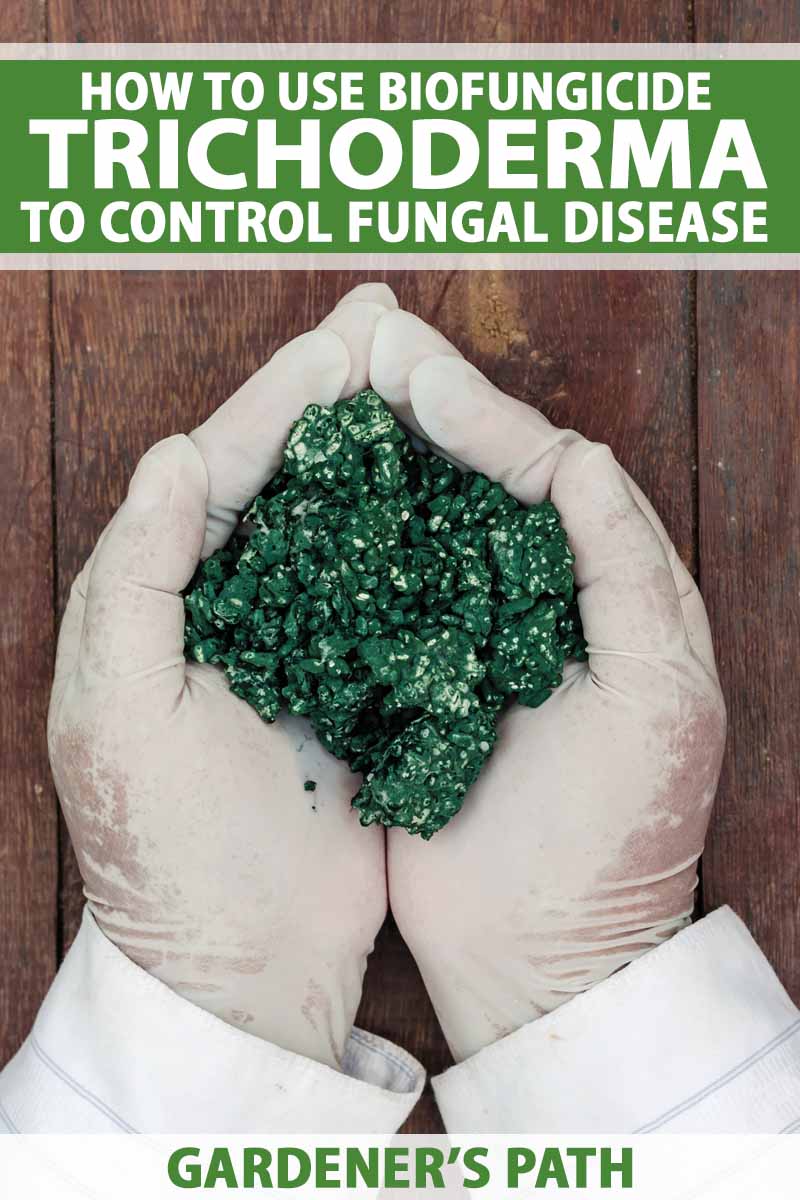
We link to vendors to help you find relevant products. If you buy from one of our links, we may earn a commission.
This fungus can inhibit a who’s who of fungal soil-borne pathogens, including Fusarium (wilts), Rhizoctonia (root rot), Sclerotinia (blight), and water molds Pythium and Phytophthora (damping off).
Trichoderma works best on plants that are not thriving. If your plants are already at their peak, you may not see an effect from adding this microbe.
However, if conditions are suboptimal, yield increases have ranged from 10 to 20 percent to as much as 300 percent.
The guide below describes exactly how this fungus improves plant growth, and provides you with tips on how to best use it.
What You Will Learn
How Trichoderma Interacts with Plants
So just how does it work? Trichoderma helps to improve plant health in a variety of ways:
Plant Root Colonization
Once in the soil, this fungus colonizes the roots of plants.
By growing on the roots and in the rhizosphere, it forms a physical barrier to prevent the growth of fungi that would otherwise cause disease on the plant.
Plants frequently produce chemicals to defend themselves, and Trichoderma is resistant to many of them, which helps it to colonize the roots.
And it does this without interfering with other microbes that help the plants, such as mychorrhizae or Rhizobium (bacteria that fix nitrogen).
Biofertilization
Trichoderma can improve plant health even in the absence of pathogens. The fungus grows best in soil that is acidic, and it helps create such an environment by secreting organic acids.
These acids have an additional effect that greatly benefits the plants – they can solubilize phosphates and mineral ions, such as iron, magnesium, and manganese.
This means they facilitate dissolving of these minerals, making it easier for the plants to absorb them. Such nutrients are often in short supply in the soil.
The increase in the yield of the plants is greater when the soil is really poor to start with.
Stimulation of Plant Defense Mechanisms
You may not know that plants have immune systems. They are able to sense invasion by pathogens and activate cascades of responses to produce chemicals to protect themselves.
Trichoderma has been shown to be able to activate plant defense responses, which enables the plant to control some infections above the ground, but their effects are not limited to just soil-borne pathogens.
An example is Botrytis, a debilitating aboveground fungus that is sometimes controlled using Trichoderma.
How Trichoderma Interacts with Other Microorganisms
Part of what makes Trichoderma such an effective biocontrol agent is that it uses a diversity of mechanisms.
That makes it highly difficult for its target organisms to evolve resistance, since they would have to become resistant to a number of different mechanisms simultaneously.
Parasitism of Other Fungi
Trichoderma can directly parasitize other fungi. First, it attaches to them. Then it coils around them and produces structures that can penetrate them.
In addition, this fungus produces enzymes that break down the fungal cell walls. This process is known as mycoparasitism, with myco meaning fungi.
Most fungal cell walls contain chitin, and strain T-22 in particular produces large amounts of an enzyme called chitinase that can degrade the cell walls of its opponents.
Trichoderma protects itself from the chitinases it produces.
Antibiotic Production
In addition to physically parasitizing other fungi, Trichoderma can attack them chemically.
It does so by producing chemicals that are toxic to the fungi. Some of these compounds are volatile and travel through the air.
The chitinases and antibiotics act synergistically, and affect the target fungus more strongly than the production of either one alone.
Competition
The soil is a fiercely competitive place, and microbes most commonly die by starvation. Trichoderma is unusually skilled at taking up nutrients from the soil compared to other organisms.
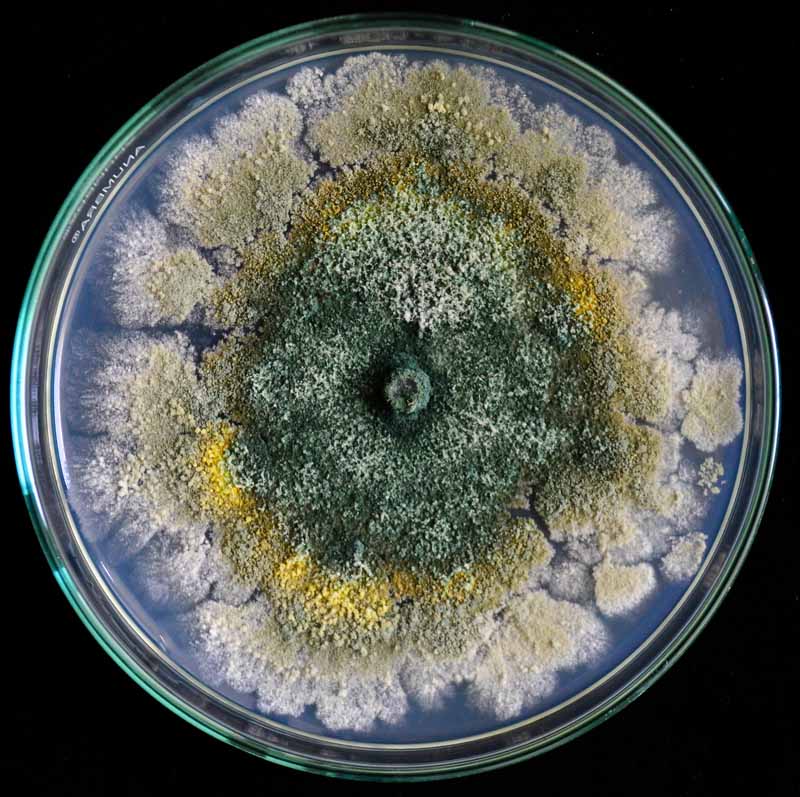
It can derive energy from complex compounds, like chitin from fungi or cellulose from plants, that are difficult for other organisms to break down.
One compound that is typically scarce in the soil is iron.
Some strains of Trichoderma produce specialized compounds called siderophores that bind with iron and make it unavailable to other fungi, totally inhibiting their growth.
Resistance to Pesticides
Many strains of Trichoderma are unusually resistant to toxic compounds, ranging from pesticides to chemicals produced by plants.
Its pesticide resistance includes herbicides, fungicides, and insecticides like DDT.
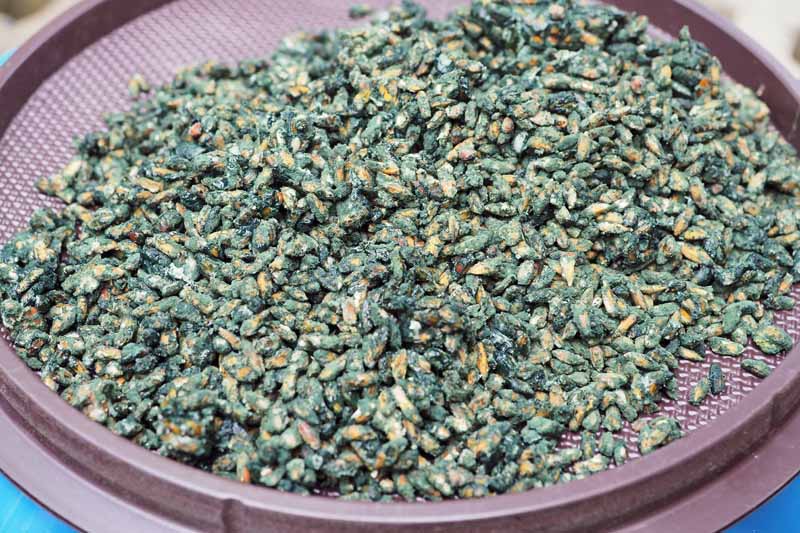
This gives an edge to using these fungi to control pathogens, since you can alternate application of strain T-22 with fungicides like benomyl or captan.
How to Use Trichoderma in Your Garden
If you apply this fungus to seed, it will colonize the plant’s root system as it grows. You can apply it directly into the furrow when planting. If you are planting turf, you can mix the fungus into the surface of the soil.
For greenhouse or nursery planting, mix with your potting medium. Apply directly into the planting hole if you are transplanting trees or shrubs.
Strain T-22 prefers warmer weather, so you should apply it when the temperature is above 55°F.
Trichoderma is a widespread fungus with no history of toxicity to humans or when tested on lab rats. However, to be safe and prevent allergies from developing, you should use a dust/mist filtering respirator if you are working with large quantities. The powder can cause eye irritation, so you should wear protective eyewear.
For small greenhouse and nursery operations or those with large gardens that need treated in bulk, we recommend RootShield® Plus, available from Arbico Organics.
This is a water soluble powder, but it also comes in a pelletized version if you want to use a spreader to treat a lawn.
If you need to treat potted plants, seedling starts, or other procedures requiring smaller quantities, you should take a look at Mikro-Root.
This product contains two strains of Trichoderma – T. harzianum and T. viride. And most importantly, it’s available from Arbico Organics in smaller quantities (from 2 oz. up to 25 lbs).
Another good solution is a blended product containing Trichoderma along with other beneficial bacteria and fungi.
The answer here is a product called Plant Thrive.
Besides three species of Trichoderma, it includes a host of biopesticides including nine different species of Bacillus bacteria including B. thuringiensis (Bt), B. amyloliquefaciens, and B. subtilis.
It also includes other plant-loving microbes such as Geobacillus stearothermophilus, Streptomyces lydicus, among others. It’s also available via Arbico Organics.
For longer term use, store these products in the refrigerator in the original container until ready for use. You may also keep them above 75°F for short periods without any loss of performance.
Larger quantities and products with various application methods for commercial horticultural uses are also available.
The Global Biocontrol Fungus
Trichoderma species are found in most types of soil around the world, and help to control other soilborne fungi using a variety of mechanisms. These range from direct parasitism to the production of antibiotics.
Fifteen years of research at Cornell University produced the powerhouse Trichoderma harzianum strain T-22, which can be used on an immense array of crops.
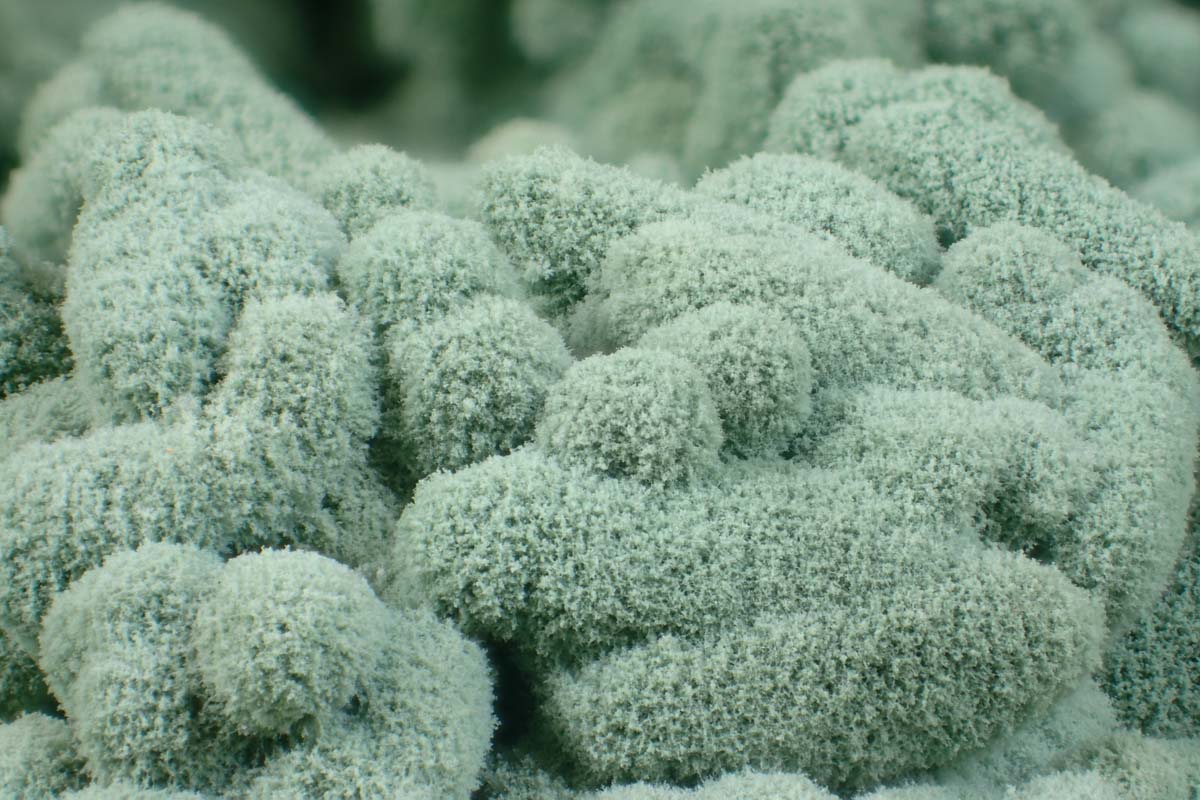
Strain T-22 can improve the nutritional status of crops in addition to controlling pathogens.
This broad-based biocontrol agent was one of the first biofungicides on the market, and remains a highly efficient fungus to add to your arsenal.
Have you used Trichoderma in the garden? If so, let us know how it worked for you.
And read on for more information on biological control agents such as:
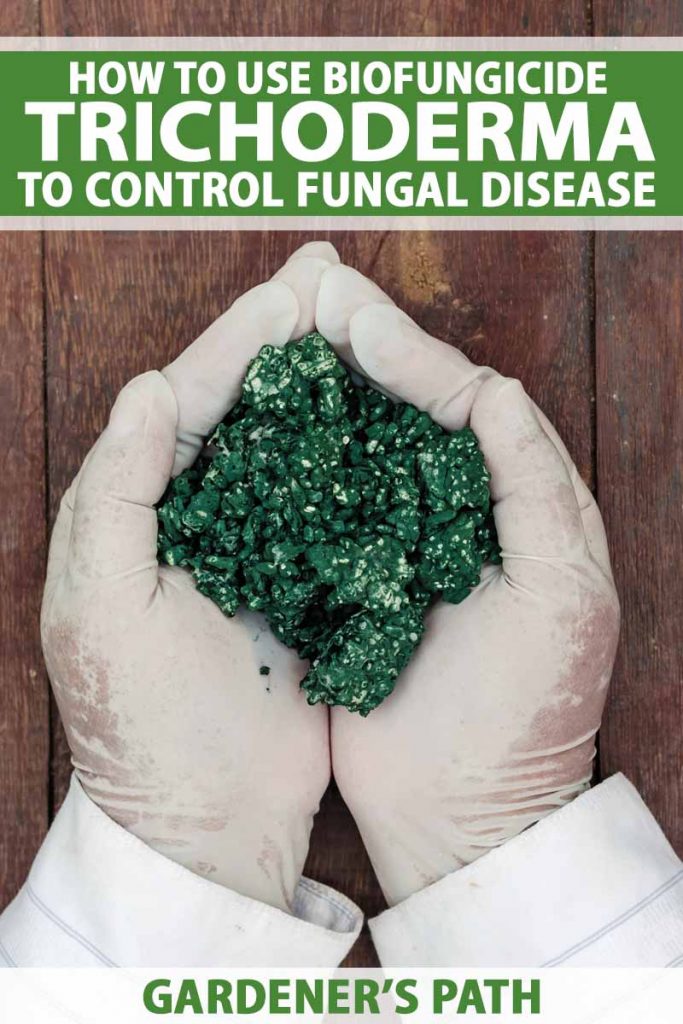
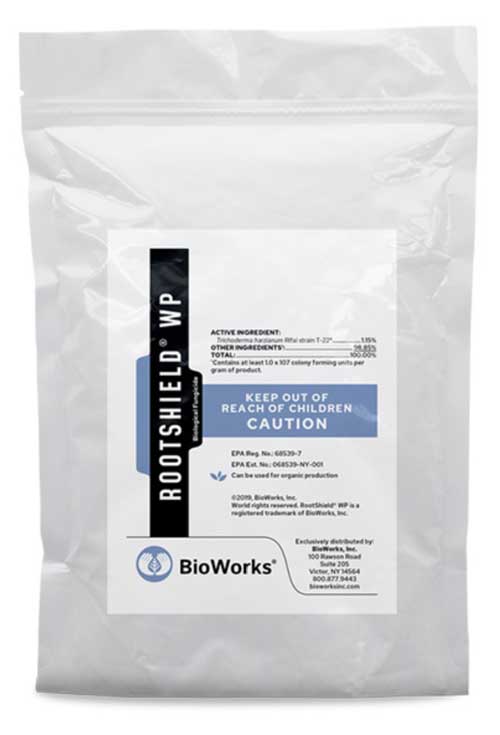
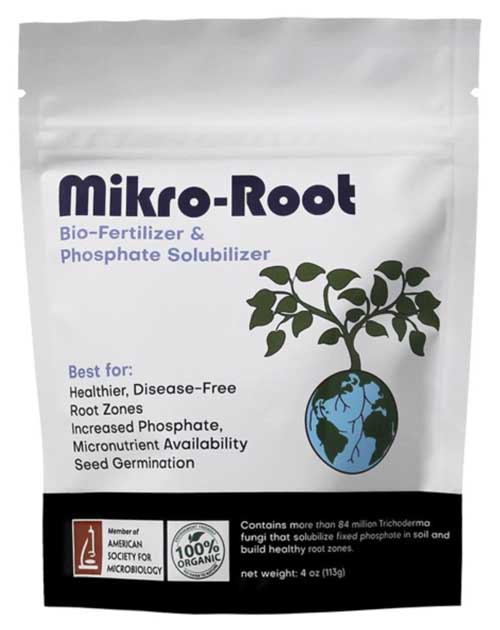
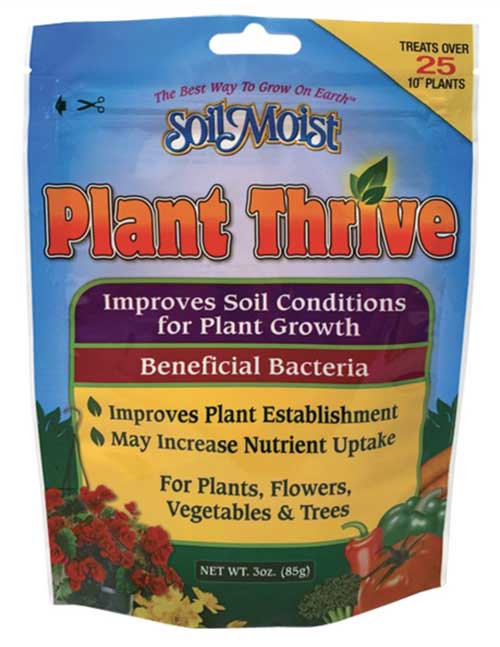
Is Serenade effective at controlling anthracnose on mango trees(Mangifera indica)?
Dear David, It was found to be less effective than fungicides when sprayed on the trees. (It was compared against thiophanate methyl and azoxystrobin.) However, if you are treating the fruit post harvest, you could try dipping them in a solution of Serenade. That works really well using a similar strain. Also, there is another biofungicide that showed progress, but I’m having trouble finding a commercial source of it. It’s Bacillus licheniformis. Please let us know if that helped to control the anthracnose. It’s such a difficult disease to control.
Hi Helga, thank you for your interest and article. I have an interest in a tropical root/tuber called yam of the Dioscorea spp.
Opportunistic fungi infection inflict a high post harvest impact on them-50% loss at 6 months.
It’s a staple in West Africa where it provides carbohydrates, protein, and minerals to the nutrition and commerce of the region. I have made some successes with humidity and temperature control but wonder if there were any natural beneficial antagonists to the usual fungi, namely Fusarium, Penicillicium, Botrydiploida, etc.
Hi Femi, Thank you so much for reposting here. Apparently, Trichoderma is very promising for controlling post-harvest diseases of Dioscorea. Bacterial antagonists are another possibility. The results that people achieve in the field can vary a great deal, and how the microbial strain is prepared can be a large factor. I would suggest that you try some of the commercialized biocontrol agents. Bacillus subtilis has been used to control post-harvest diseases in that type of yam. There is a commercial preparation called Serenade Max that is widely used. Other possibilities include Amylo-X (Bacillus amyloliquefaciens) and the fungus Aureobasidium pullulans (Botector).… Read more »
Hello,
Does this fungi accelerate the decomposition of organic matter in the soil? If so how fast it can do for a ton?
Hi Viswanath,
Thank you for you question! Trichoderma colonizes the area around plant roots, so it would not be a good choice to use to degrade a large quantity of organic matter in the soil. Some types of mycorrhizae have extensive networks of mycelia that degrade organic matter in the soil. However, I don’t know if they would be appropriate for the large quantity that you want to degrade.
I haven’t been able to find one with a quick search, but there should be products containing fungi and/or bacteria that are effective at degrading large quantities of organic matter.
Hello again Visvanath,
Hopefully you were able to find a suitable product to help you. However, if you haven’t, I just ran across what sounds like the perfect product for what you are trying to do. It’s a stubble digester with Bacillus subtilis and Pseudomonas putida to accelerate the breakdown of organic matter in the soil. The product’s name is BioAct SD, and it’s carried by Arbico Organics.
How would this product work when we transplant our Indica or Sativa plants? We have a bit of mold problem on the coast with foggy days in the summer and dripping wet nights.
Hi Pat,
What a great question! I can’t say how it would work for you on the coast, but it is common for organic cannabis growers to use Trichoderma to control disease and increase yield. It has been found to colonize cannabis plants, so it sounds like a good approach for you to try.
Let us know how it works for you!
Hi Helga, I have some issues related to my pepper, jackfruit, guava, pomelo and lemon. Hope you could give best solutions to my crops. Thanks 1/ Pepper trees continue die due to roots spoil in the ground. 2/ Jackfruit trees having broken body stem, many black ants are there and worm drilling hold in the body stem. 3/ Guava tree look yellow on the leaf and some trees are die. 4/ Pomelo having 4 to 5 years age, fruiting are less on some particular trees but most trees having o fruit at all. 5/ Lemon trees having less fruit, I’m… Read more »
Hi Chhay,
It would be best to register for our forum and post each question the applicable sub forum rather than answer these questions here which aren’t relevant to this guide and of which other members of the community might be scanning for answers.
Helga or one of our other staff writers or other community members will be along to help you out.
Will it helpful for a rose tree which is very badly effected by fungus and bacteria?
Hi Pradip,
I’m so sorry to hear about your roses. Trichoderma can help protect plants when fungi are on the roots, but it wouldn’t work well on infections that are above the ground.
For both bacteria and fungi, you could try a different type of bio-pesticide.
A good one is Monterey Complete Disease Control that affects both fungi and bacteria. You can buy it from Arbico Organic.
If you have time, please let us know how well it works for you!
our dragon fruit farm is infested with anthracnose, Can we use this to help control it?
Hi Zonia,
I’m sorry that your farm has anthracnose. It’s such an awful disease.
I’m not positive that it would work with dragon fruit, but there are a lot of reports of people using Trichoderma to control anthracnose on fruit.
I would suggest trying it on a portion of your farm to see how it works, and then deciding whether to apply it on a large scale.
Please let us know how it works! I hope it will work for you.
You can use Antracol and Monceren from Behn Mayer.
What dose of trichoderma harzianum, pseudomnas fluorescens and neemcake should we use to promote plant growth?
Hi Diksha,
Thank you for your question.
I think you need to use the manufacturer’s information on how much Trichoderma harzianum and Pseudomonas fluorescens to use. There are many different strains, and I think that the preparations vary in how much active organism they contain.
For the neem cake, you should apply 44 pounds per square feet.
I hope that helps.
Hi Helga,
I am experimenting with growing protea in heavy clays that have been turned up to 36 inches then trailered for planting holes. These holes were mixed with humic compost 60/40 with the clay soil then plants were planted. Will tricoderma break down the compost as in nitrafication ?
Hi Ben,
That is exciting that you are growing Protea!
Trichoderma does break down the carbon in compost, including compounds like lignin that are normally difficult to degrade.
I can’t find any information indicating that they perform nitrification. However, they do enhance the process by increasing the number of ammonia oxidizing bacteria and archaea. So, overall they do cause nitrification, just indirectly.
I hope that helps and wish you the best with your plantings!
Ma’am. We have been processing jute roots by softening roots and stem by applying bran culture. Can Trichoderma help for softening bark (jute stem)?
Regards
Raman
Ii am working on biocontrol agents, biofertilizers, biofungicide, active decomposers and PGPF for last 28 years. I have developed liquid and solid state bioformulations with tested field and lab. Experiments. Tested crops were wheat, rice, maize, mung beans, tomatto, citrus, garden flower, vegetables, grass lands etc. It is ecofriendly, support organic farming, antipollutant and so on……..